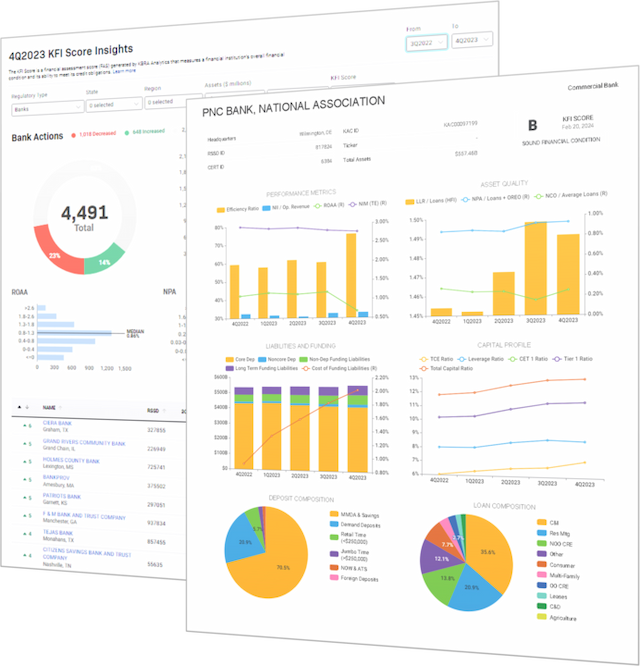KBRA Financial Intelligence
Bank Earnings Flag Potential Wave of Credit Losses, Loan Loss Reserves Jump to Three-Year High
By KFI Staff
The largest U.S. banks began reporting quarterly earnings earlier this month. A trend that has become increasingly prominent among banks’ press releases throughout the past couple of years, and persisting in the most recently reported quarter, is an accumulation of allowances for loan and lease losses. These loan loss reserves (LLRs) serve as a contra-account that banks use to offset future losses on outstanding loans that may have fallen into delinquency and could eventually be charged off. LLRs tend to rise when banks anticipate adverse economic developments that could threaten the health of their lending assets. As funds are provisioned as LLRs, they are recorded on the income statement as an expense since there is a chance that the funds will be needed in the future to counter lending losses. However, if banks overprovision in anticipation of greater losses that never materialize, LLRs can be released and reclaimed as income in later quarters.

From March 2021 to June 2022, U.S. banks released a significant portion of their LLRs, reducing them by $58.76 billion—equivalent to 27.2%. While banks had largely expected the onset of the COVID-19 pandemic and subsequent lockdown measures to tank economic growth and increase the rate of charge-offs they would need to account for, unprecedented stimulus measures reversed a short-lived 2020 recession and supported aggressive GDP expansion across numerous quarters. Simultaneously, government-backed loan forbearance, eviction moratoriums, and other temporary federal programs, allowed many consumers to remain current on (or even pay down) outstanding debts. As such, banks’ swollen tally of LLRs began to fall without a material increase in charge-offs, implying that reduction in reserves largely flowed back into their bottom line.
This supercharged the profits of numerous publicly traded parent organizations of U.S. commercial banks, with some bank holding companies (BHC) like JPMorgan Chase & Co. (KFI Score: B+) releasing as much as $5.2 billion from its reserves back into company earnings throughout 1Q 2021 alone. In contrast, the bank’s more recent 3Q 2024 earnings results showed a net build of $1 billion in its allowance for credit losses. Smaller, privately held depositories also tend to benefit from negative provisioning. Key financial ratios like return on assets (ROA), return on equity (ROE), and net interest margin (NIM) typically rise in the wake of a sudden jump in net income. According to KFI’s dataset, 60.5% of 4,502 commercial banks that reported loans in 2Q 2024 disclosed increases to their credit loss allowances, while a smaller 28.8% saw reductions. The remaining 10.7% left LLRs unchanged from the prior quarter.
The latest H.8 data release from the Federal Reserve reveals that total LLRs in the commercial banking system have now surpassed $202 billion, the highest level since March 2021. The increase has been more gradual compared to 2020 levels, but is nonetheless symptomatic of an expectation that more bank loans could soon be at risk of going bad. Consumer loans have seen a particularly concerning increase in delinquency, mainly driven by the credit card segment. The sum of U.S. credit card debt and similar revolving plans is now greater than $1.07 trillion and continues to grow at a YoY pace of 5.4% in October. The accumulation has continued despite the average APR on credit cards exceeding 20% since early 2023.

Since reaching a trough in 3Q 2021, the rate of credit card delinquencies has more than doubled to a 12-year high of 3.3%. The rise in credit card delinquencies has been steeper than all other loan categories. Capital One, National Association (KFI Score: C+) led all commercial banks in expanding its LLRs in 2Q 2024, positing a net build of nearly $1.3 billion to cover potential credit losses. That comprised the entirety of the allowances that its BHC, Capital One Financial Corp. (KFI Score: B), reported in the quarter. Capital One, N.A.’s credit card loans account for 44.1% of its total lending. The change in Capital One’s LLR provisioning will undoubtedly be in focus once again when it reports 3Q earnings after the close of trading on October 24.

Larger commercial banks have accumulated significantly higher levels of exposure to credit card debt as a share of total lending, but only moderately higher rates of delinquency on average. The 27 commercial banks with more than $1 billion in credit card loans are experiencing an average delinquency rate of roughly 4%, while a cohort of 83 banks with $10 million to $1 billion in credit card loans has seen an average of 3.2% of those loans fall into delinquency. Individual banks and credit unions can be sorted by the delinquency rate of various loan categories using the Data Wizard in KFI’s Excel add-in. Alternatively, the Loan Category and Delinquency Report template from our Template Library details the portfolio breakdown with customizable visuals and tables. Request a demo with KFI to access our full library of tables and templates.
Although a steady uptick in LLRs is a signal that banks expect their loan books to face greater risk emanating from a potential cooling of economic growth and financially stressed consumers, inflation is trending lower, and a series of rate cuts are set to contract borrowing costs. The Fed continues to target a “soft landing,” wherein the central bank successfully exits a monetary tightening cycle without inadvertently causing a recession. If this coveted soft landing can be achieved, it would likely head off a more serious deterioration of banks’ loan books, potentially facilitating another round of negative provisioning, and boosting their bottom lines in the future.
